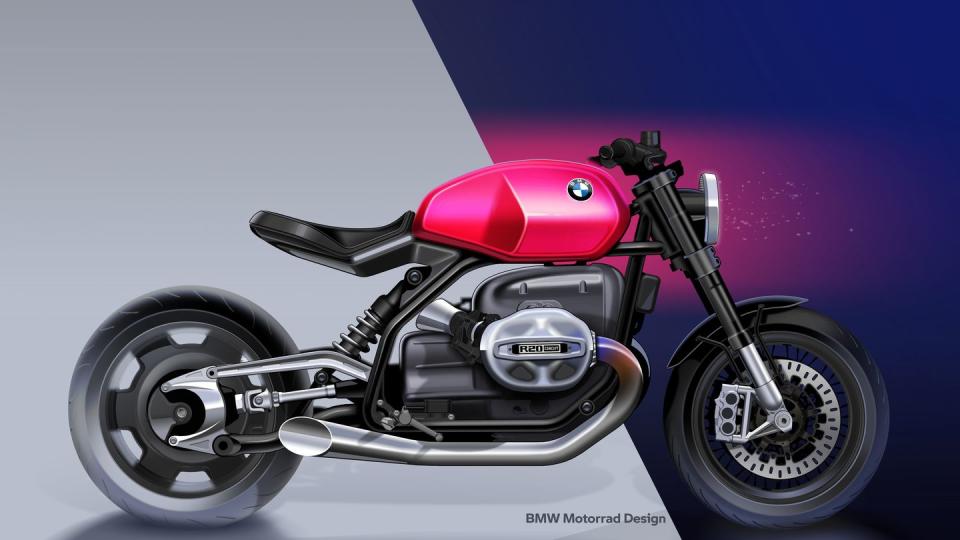BMW R20 Concept Wows Villa d’Este

BMW unveiled this cool concept motorcycle at the swanky Concours Villa d'Este in Italy, where it also showed the Concept Skytop automobile.
The bike gets a big, new 2000-cc flat twin engine, the biggest BMW motorcycle powerplant ever made. No word on output or construction of the block.
No word, either, on production, but BMW can use all it can get to take on moto-giants like Harley and Honda.
With over 20 percent of the U.S. market in its clutches, Harley-Davidson is the biggest-selling motorcycle maker in America, and God Bless America. That’s followed by: Honda, Yamaha, Kawasaki, and Suzuki, in that order. But BMW makes a legitimate competitor to the big V-Twins from Milwaukee and its many competitors.
The latest salvo fired from Berlin on the big bruiser market segment was launched last weekend at the highbrow Villa d’Este concours, the BMW R20 Concept.
Built around the biggest version yet of the BMW two-cylinder flat twin, the R20 Concept’s engine displaces 2000 ccs, according to the boys at Beemer. And it’s around that largest-displacement-yet engine that BMW built the rest of the bike.

"The BMW R20 concept is a mechanical masterpiece, (and) the Big Boxer is its center," said Markus Flasch, Head of BMW Motorrad. "Distinctly BMW Motorrad."
You may already know the BMW R18 motorcycle launched four years ago. It has an 1802-cc flat twin making 91 hp and 116 lb ft of torque. BMW did not say all the things it did to make the 2000-cc flat twin around which the R20 Concept is built, but it did allow that the air-oil-cooled Big Boxer engine got new cylinder head covers, a new belt cover and a new oil cooler.
It’s not clear whether the cylinders themselves were bored and/or stroked to make 2000 ccs, or whether they’re all-new.
Other details were more forthcoming: The chassis has been completely redeveloped, BMW said, with a black double-loop main frame made of chrome-molybdenum steel tubes that forms the bike’s backbone.
The rear wheel is a black disc design measuring 17x6.25 inches wrapped with a 200/55 tire. In front is a 17" wheel with black spokes and a 120/70 tire. Connecting the wheels to the rest of the motorcycle is a new take on the BMW paralever suspension system, which combines the tasks of rear suspension and power transmission in one, with a driveshaft routing torque to the rear wheel. This system has been executed in a new two-arm variant with the swingarm made of chrome-molybdenum steel and the Paralever strut made of aluminum.
"The kinematics are designed so that the drive torque is completely balanced," BMW said.
The two milled aluminum rear axle carriers also stand out stylistically, as does the exposed driveshaft, conceptually adopted from the R18 – the visual highlight of the well-known R 18 models. It has been shortened for integration into this architecture. Fully adjustable Öhlins Blackline shocks work at the front and rear.
For those who want more detail, the basic vehicle geometry has a steering head angle of 62.5°, as well as a wheelbase of 61 inches. Brakes have radially mounted calipers from ISR front and rear, with six pistons front and four rear. Additionally, the 2-in-2 exhaust system “delivers the appropriate sound character and perfectly completes the design.”
Atop it all is an aluminum gas tank coated in a color called “hotter than pink.”
Overall, it’s not a cruiser like the R18 was, but what BMW calls a roadster. It seems to exist in a category floating around between sport bike and cruiser.
Will BMW make it? It has made something like five variations of the R18 in the last four years, so you could assume, all on your own, that yes, this bike will likely see production, though there was no such announcement made.
But will it make a difference? Harley and Honda each get around 20 percent of the moto-market in the U.S., according to Statista.com, with Yamaha and Kawasaki taking around 12 percent apiece, and Suzuki about five points. Poor BMW struggles to eke out three percent, at least in the United States.
For BMW, innovation and exciting new models must go a long way to bringing it into competition with the biggest brands selling in America.

 Yahoo Autos
Yahoo Autos 